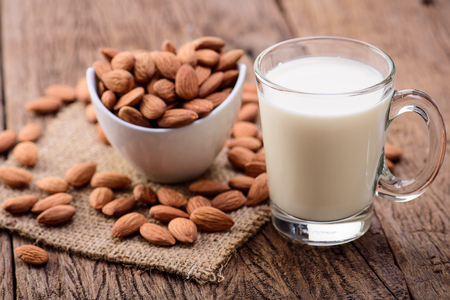
Almond milk is to be found on most supermarket shelves but it has caught many by surprise by its popularity. It is rapidly becoming the main alternative to soy milk for vegetarians and vegans and even regular dairy milk especially at breakfast time. Allied Market Research has recently identified it as a product enjoying a high compound annual growth rate (CAGR) of about 15 per cent which should continue for a number of years at least. The global market for all these milk alternatives was about $5.8 million in 2014 and $6.9 million in 2015. Remember, the dairy market is still at least 10 times this level! Nielsen, another global marketing research business reckons that growth of nut milks is about 8% year on year (YOY).
The product developers have been busy too on this product. These milks now come in unsweetened and sweetened forms, vanilla and chocolate flavours, organic variants and with added vitamins and minerals. It seems to be the way of the world that products like these appear. What hasn’t happened is the creation of an almond milk suitable for coffee shops. I’m sure the baristas will be crying out for a plant-based beverage that functions like milk for frothy, creamy coffee making.
Why Non-Dairy Milks?
The interest in these nut milks began around 2013 in response to a desire for alternatives to that other great vegetarian milk, soy milk. One of the issues that confronted users of soy at the time was the GMO issue and alternatives were sought simply to get round this. The reasons incidentally for the rise in non-dairy milks is the high lactose intolerance of a vast portion of the global population especially in the East (Asia and Pacific regions), some rising milk allergies and the increase in vegetarianism or veganism. The demand in Asia is extremely high because at least 90% of the population is lactose intolerant.
Overcoming The Rise In Obesity
One of the reasons for such unparalleled growth in nut milk is also due to a global need to reduce weight and level of obesity, none more so than in the USA and Europe. Consumers now see almond milk as well as other types to be generally healthy as well as offering ‘free from dairy’ alternatives, having vegetarian and even vegan status.
In many cases, the vegan diet is perceived to be much healthier which means that diets are rapidly altering and almond milk is part of that change. The nutrition of the nut milk however still needs to be improved upon even when vitamin and mineral claims are made. Dairy milks are strongly associated with calcium – the building and strengthening of bones is a very attractive marketing proposition. Calcium in milk is thought to be better absorbed along with vitamin D with which dairy is associated with.
The amount of vitamin D in plant beverages varies. A 2014 study of 2,813 children noted that those who drank non-cow’s milk beverages had much lower blood levels of vitamin D that those drinking cow’s milk (Lee et al., 2014).
Nut milks also rely on additives such as lecithin to emulsify other ingredients. That in itself is not a problem save that it raises suspicions about the integrity of the product. One other issue which dairy milks seem to be able to take advantage of is the lack of thermal or heat stability of almond milk in hot drinks.
Have you ever tried cooking with it? Not an issue in baking where it helps in the formulation of cookies for example!
Future Growth
If you examine the US market, the non-dairy alternatives may well be over 13% of the total milk market far into the future. This is also projected to rise to $10.9 billion in 2019 and an estimated $21.7 billion in total over the next six years. The challengers to almond will be other nuts, pea and hemp milk. Mintel also reported a meteoric rise for the non-dairy milk alternatives. They have shown in research for 2017 that sales of all these milk alternatives has increased by61% since 2012 to about $2.11 billion in 2017. The breakdown is that almond milk enjoys 64% market share, soy has 13% and coconut has 12%. These are the category leaders. Producers are avidly looking for alternatives because consumers in Europe and the USA are looking to diversify their non-dairy milk repertoire. One fly in the ointment though might be the naming of the product. Can it be called a milk ?
What we should see is an interesting rise in a great variety of different ‘milks’ as they come onto the market, with each offering slightly different sensory profiles
Revised 23rd October 2018 to include statistical growth information.
References
Lee, G.J., Birken, C.S., Parkin, P.C., et al. (2014) Consumption of non–cow’s milk beverages and serum vitamin D levels in early childhood. CMAJ : Canadian Medical Association Journal. 186(17) pp. 1287-1293. https://doi:10.1503/cmaj.140555.
Please note this article contains links to our affiliate marketing partner. Please read our affiliate disclosure.



Leave a Reply